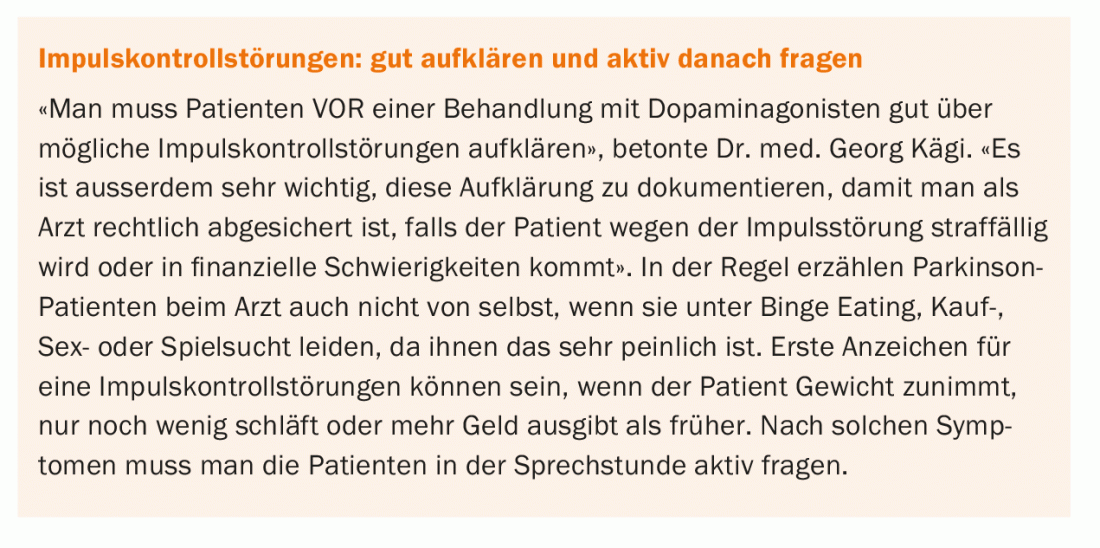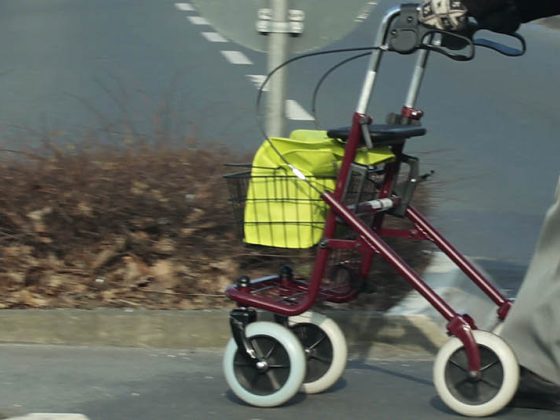On March 5, 2015, the 8th “Neurology Update” already took place in St. Gallen. Physicians from the Neurology Department of the Cantonal Hospital St. Gallen provided information on news and controversies, including MS therapy, restless leg syndrome, anticonvulsive therapy, stroke and Parkinson’s disease. Particularly interesting were the two “pro and con” presentations, in which two speakers crossed blades on a controversial topic.
“Just 20 years ago, multiple sclerosis was untreatable,” Stefanie Müller, MD, opened her presentation. “Since then, the situation has changed fundamentally – new MS therapeutics come onto the market virtually every year.” Last year, these were the products alemtuzumab (Lemtrada®), which is primarily used for escalation therapy, and the third oral MS agent dimethyl fumarate (Tecfidera®).
Dimethyl fumarate in multiple sclerosis
The efficacy of dimethyl fumarate was investigated in the two studies CONFIRM and DEFINE. They showed a 50% reduction in annual relapse rate and a 32% reduction in annual disability increase and a decrease in MRI lesions. Since August 2014, dimethyl fumarate has been available as first-line therapy; the drug is taken twice daily at a dose of 240 mg. Typical side effects include flushing symptoms (redness, heat, burning, itching) and gastrointestinal symptoms (diarrhea, pain, nausea, vomiting), but these usually subside after the first month. Most patients are able to cope well with flushing symptoms; if they are severely bothersome, they can be treated with the selective use of aspirin. To avoid gastrointestinal discomfort as much as possible, it is recommended to titrate the dose (only 120 mg in the first eight days), take the drug with a meal, and swallow the capsules whole. In most patients, the leukocyte count is reduced by about 10% in the first year of treatment, but this does not increase susceptibility to infection. In Switzerland, pre-existing leukopenia is nevertheless a contraindication for the administration of dimethyl fumarate. To date, there is no evidence of adverse effects in pregnant women; however, dimethyl fumarate should be discontinued if pregnancy is diagnosed.
“It is becoming increasingly difficult to counsel MS patients regarding medication,” the speaker said. “At the moment, there are four preparations available for injection, three in tablet form and two as infusions. Therefore, the decision is mostly made individually, for example, based on family planning, side effects or personal preferences.” As more MS therapeutics can be expected to come onto the market in the next few years (daclizumab, peginterferon, ocrelizumab), patient counseling will become even more complicated.
Medication for restless legs syndrome
Dominique Flügel, MD, provided information on current therapeutic options for restless legs syndrome (RLS). Among 35-year-olds with RLS, the gender distribution is still 1:1; among older people, women have twice the risk of RLS as men. One possible cause is relative iron deficiency during pregnancy. A common comorbidity is depression. Because SSRIs, like many other drugs, can trigger RLS, depressed patients with RLS should be treated with bupropion rather than SSRIs.
Most RLS patients respond quickly and well to L-dopa, but the risk of augmentation is high: symptoms become more intense and start earlier in the day, and occasionally they rise to other parts of the body. This is clearly an iatrogenic phenomenon. Treatment with dopamine agonists (DA) also carries the risk of augmentation, but it is lower than with L-dopa; on the other hand, DA can trigger impulse control disorders (see box).

Current treatment recommendations suggest DA as first-line therapeutic agents for severe symptoms, severe obesity, comorbid depression, increased risk of falls, or cognitive impairment. Gabapentin and pregabalin are the first choice for severe sleep disturbance, pain, comorbid anxiety disorder, or a history of impulse control disorder. Second choice is the combination of a DA with gabapentin or pregabalin or the administration of an opioid (tramadol, codeine, oxycodone-naloxone, tilidine). Development of tolerance to the opioids is rarely seen in these patients.
Basically, the following applies to all drug treatments for RLS:
- Only use drugs when suffering
- Dose medications as low as possible
- Keep an eye on a possible augmentation resp. Have impulse control disorders under DA
- Medical check-ups every 6-12 months.
Antiepileptic drugs already after the first seizure?
How to proceed if a patient has suffered a first epileptic seizure? Should we prescribe an antiepileptic drug or rather wait? There are no easy answers to these questions – experts disagree. Dominik Zieglgänsberger, MD, represented the pro faction at the Neurology Update, while Prof. Barbara Tettenborn, MD, represented the con faction.
Pro: Various studies have shown that the probability of a second seizure within two years is relatively high. It is 50% in untreated patients, 25% in treated (FIRST trial). In the MESS trial, 39% of untreated patients experienced a second seizure. The risk of recurrence was increased in patients with pathologic EEG findings, focal seizure onset, seizure during sleep, or pathologic neurologic findings. However, even in the group with the lowest risk of seizures, 30% of patients had had a second seizure after four years (MESS trial). The risk of recurrence is increased in children and adolescents, as well as in the elderly over 65 years of age.
Dominik Zieglgänsberger pointed out that epileptic seizures also have serious psychosocial consequences: Accidents, ban on driving, occupational restrictions (construction work, shift work) and restrictions in leisure time (swimming, risk of drowning in the bathtub, risk of injury). Many patients fear recurrence of seizures and respond with social withdrawal. Another risk is the so-called SUDEP (“Sudden unexplained death in epilepsy patients”); the most important risk factor for SUDEP is a high seizure frequency. All of these risks argue for treating patients with an antiepileptic drug after the first seizure.
Contra: After a first seizure, the first question is whether it was an epileptic seizure at all. And if so, was he really unprovoked? Two studies showed that an initial “epileptic” seizure was misdiagnosed in 25% of cases. Thus, there is a high probability of treating patients who do not need antiepileptic therapy. “We should not forget that 50% of all patients who are started on antiepileptic treatment will continue this therapy for life,” Prof. Tettenborn said. This means that many patients are exposed to the often significantly limiting side effects of antiepileptic drugs. These include:
- Influences on consciousness and gait
- Worsening of cadiovascular risk factors.
- Impaired bone metabolism: epileptics over 50 have a threefold increased risk of hip and femur fractures
- Cosmetic impairments: Coarsening of facial features, gingival hyperplasia, weight gain.
- Higher rate of unwanted pregnancies
- Fertility disorders
- Teratogenic effects (children whose mothers took anticonvulsants during pregnancy have increased cognitive impairment).
- Interactions with other drugs.
“Most patients are afraid of having another attack and refuse to stop the medication, even if they have to put up with side effects,” the speaker said. However, the long-term prognosis is not changed by the drug! And even elderly patients very rarely suffer seizure-associated injuries. “Ultimately, the decision to take or not take a drug is very individual, depending on the patient’s lifestyle, occupation and preferences, among other factors.”
Swallowing disorders after stroke
50% of all patients suffer from dysphagia immediately after a stroke, informed Georg Kägi, MD. After seven days, 18% still have severe dysphagia, and after 30 days, 9% still do. Swallowing disorders are associated with poor outcome. To date, there are no scores that can be used to predict how long dysphagia will last. However, this information would be important so that the further procedure can be planned, for example the insertion of a nasogastric tube or – in the case of prolonged dysphagia – a PEG tube. In St. Gallen, the PRESS score was developed for this purpose and can help predict the duration of dysphagia. Currently, this score is being validated in different centers in Switzerland (Stroke Swallowing Study).
Parkinson’s disease: deep brain stimulation early in the disease course?
Deep brain stimulation (DBS) in patients with severe Parkinson’s disease is a well-established treatment option that has been used in more than 100,000 patients since 1987, Nikolas Wegener, MD, said in his presentation. DBS has many advantages: it works continuously without fluctuations, improves symptoms and quality of life, usually allows a reduction in medication dose, and is potentially reversible. In most patients, DBS primarily improves symptoms in the off state but has little effect on the on. Today, a Parkinson’s patient must be objectively severely impaired to undergo DBS: DBS is mostly used as a therapy in the far advanced stages of the disease, when partly irreversible psychosocial problems already exist, such as disease-related retirement from work or social isolation.
In a study by Schüpbach et al. (Earlystim study) investigated the hypothesis that DBS earlier in the course of the disease would provide better long-term quality of life and delay psychosocial problems. In the study, surgery was performed early in the intermediate phase (after the honeymoon phase, when fluctuations begin). For all endpoints such as quality of life, mobility, etc., the DBS patients performed significantly better than the patients without DBS. “However, many questions regarding DBS in earlier stages of disease are still open,” the speaker emphasized. Thus, it is currently unclear whether these results are also applicable to older patients, because in the Earlystim study primarily younger patients with DBS were treated (median: 52 years). In addition, there are some symptoms that may not improve or may even worsen under DBS, such as postural stability, disease progression, and degenerative processes. If surgery is performed early in the course of the disease, the aggregates have to be changed more often, which means a surgical risk for the patient each time. And since there is still little long-term data over several decades, it is not yet known how the implants will hold up over the years (cable breaks, etc.).
Dopamine agonists: yes or no?
Should we use dopamine agonists (DA) to treat PD or not? Stefan Hägele, MD, as proponent, and Georg Kägi, MD, as opponent of this therapy option, underlined their respective positions with good arguments.
Pros: DAs are effective both as monotherapy and in combination with L-dopa. They help save L-dopa and lead to dyskinesia less frequently over 3-5 years compared to L-dopa monotherapy. Because of the dopamine-sparing effect, younger patients (under 70 years of age) should begin therapy with DA.
In Parkinson’s disease, there is also a hypodopaminergic imbalance, which often manifests itself as apathy, a typical hypodopaminergic behavior pattern. Here, too, DA can bring an improvement. Of particular note are hypodopaminergic states in the context of DA withdrawal syndrome or mesolimbic imbalance following medication reduction after DBS. DA are also used here with success.
Contra: Studies show that quality of life is worse with DA than with L-dopa, even though patients with DA have fewer dyskinesias. The reason is that because of their lower efficacy, DA not only prevent dyskinesias but also give the patient less on-time. Because of their binding to D3 receptors, DA trigger neuropsychiatric side effects, primarily impulse control disorders (binge eating, shopping addiction, sex addiction, gambling addiction). These occur 13 times more frequently under DA therapy than under L-dopa and can have a devastating impact on patients’ social lives (see box).
Both speakers agreed that dyskinesias are not infrequently overstated – and by the physician. Many patients do quite well with the dyskinesias as long as there is also enough on-time.
Source: 8th Update Neurology, St. Gallen, March 5, 2015.
InFo NEUROLOGY & PSYCHIATRY 2015; 13(3): 28-31.












